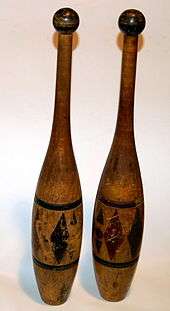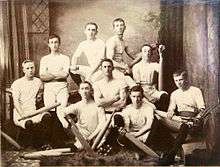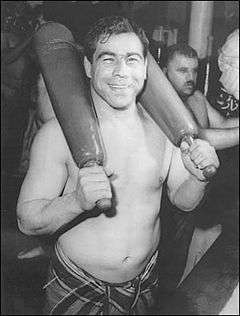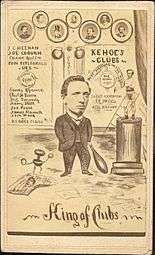Indian club

Indian clubs, or Persian meels (also mils), were a 19th-century type of exercise equipment used to present resistance in movement to develop strength and mobility. They consist of bowling-pin shaped wooden clubs of varying sizes and weights, which are swung in certain patterns as part of a strength exercise program. They can range in weight from a few pounds each to special clubs that can weigh as much as up to 100 pounds. They were used in carefully-choreographed routines in which the clubs were swung in unison by a group of exercisers, led by an instructor, similar to the USA's 21st century aerobics or zumba classes. The routines would vary according to the group's ability along with the weights of the clubs being used.
Despite their common English name implying an Indian origin, the so-called Indian clubs were in fact originally found in Persia, where they are referred to as meels or mils (Persian: میل, translit. mil).[1][2] The earliest records of this type of resistance device being used by wrestlers predates the 19th century, in ancient Persia, Egypt and the rest of the Middle East. Their practice has continued to the present day, notably in the varzesh-e bastani tradition practiced in the zurkaneh of Iran. From Persia, the Mughals brought meels to India, where they are still used by pehlwan (wrestlers) today. When the 19th century British colonists came across meels in India, they naturally referred to them as "Indian clubs," ignoring their Persian origin.
Exceptionally popular during the fitness movement of the late Victorian era, used by military cadets and well-heeled ladies alike, they appeared as a gymnastic event in the 1904 and 1932 Olympics. Gymnasiums were built solely to cater to club exercise groups. During the late 19th and early 20th centuries they became increasingly common in Europe, the British Commonwealth and the United States.
Circa 1913/14 the Bodyguard unit of the British suffragette movement carried Indian clubs as concealed weapons for use against the truncheons of the police[3].
The popularity of Indian clubs waned in Europe during the 1920s and 1930s as organized sports became more prevalent. Regimented exercise routines, like those requiring Indian clubs, were relegated to professional athletes and the military, who had access to more effective and modern strength training equipment.
While torches and other stick-like objects have been used in juggling for centuries, the modern juggling club was inspired by Indian clubs, which were first repurposed for juggling by DeWitt Cook in the 1800s.
There are physical fitness enthusiasts reviving the usage of Indian Clubs in the early 21st century, citing the aerobic exercise and safety advantages over traditional free weight regimens. There are nostalgic replicas of the original clubs being manufactured, as well as modern engineering updates to the concept, such as the Clubbell.[4][5]
Gallery
 Indian club swinging team, 1890s
Indian club swinging team, 1890s- An Indian pehlwan (wrestler) training with clubs c. 1973
 Iranian jahan pahlevan, Takhti, with clubs c. 1957
Iranian jahan pahlevan, Takhti, with clubs c. 1957 Carte de visite of Sim D. Kehoe, who brought Indian clubs to the United States from England
Carte de visite of Sim D. Kehoe, who brought Indian clubs to the United States from England_-_Yazd_-_Central_Iran.jpg) In Iran
In Iran
See also
References
- ↑ "Muscular Shias return to roots". BBC News. 22 April 2004. Retrieved 2018-02-07.
- ↑ Specimens of the Popular Poetry of Persia: As Found in the Adventures and Improvisations of Kurroglou, the Bandit-minstrel of Northern Persia and in the Songs of the People Inhabiting the Shores of the Caspian Sea. Oriental Translation Fund of Great Britain and Ireland. 1842. p. 457.
- ↑ 1858-1928,, Pankhurst, Emmeline,. My own story. London. ISBN 1784871257. OCLC 925307642.
- ↑ "Clubbell training". Stumptuous.COM. 18 July 2008.
- ↑ English, Nick (15 November 2016). "The Surprising Benefits of Club Training for Strength - BarBend". BarBend. Retrieved 2 April 2017.
External links
| Wikimedia Commons has media related to Meels. |